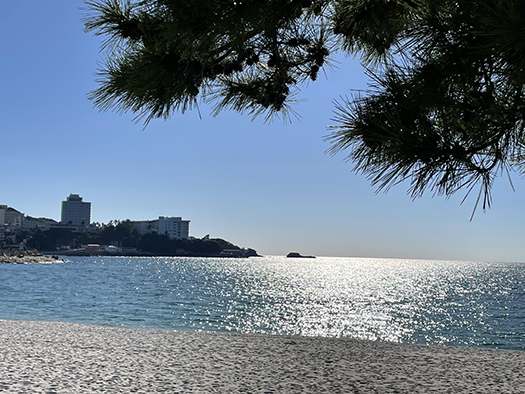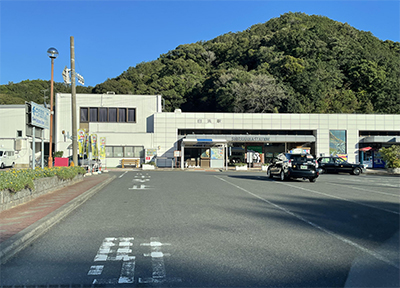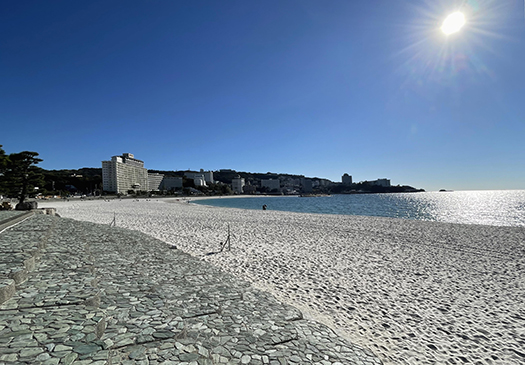

みなさんどなたも「憧れの土地」みたいな感傷はあるでしょう。実際にそこに行った体験は徐々に風化したり、逆に美化されたりして、あんまり「まんま」感はないのでは。
わたしは一区切りついた感はあるのですが、仕事への意欲もまた盛り上がってきています。そういった気分には熊野の空気感に籠もっている「再生」という雰囲気がピッタリ。で、実際に熊野をあちこちと歩いていて、ふと、南紀白浜がすぐ近いことを思い出してしまった。これはわたし的な独特の思いでして高校時代、といっても1年休学したあとの「再生の3年」時、気のいい後輩の友人たちがわたしだけが修学旅行に行けないことに同情してか「大阪万博、見に行きましょう」と盛り上げてくれたのです。
わたしは別に修学旅行に2度は行けないことにはなんの痛痒も,残念感もなかったのですが、せっかくの友人の申し出だったので、「ありがとう」と出掛けたのですね。
で、男子高校生3人の珍道中(笑)。
万博会場の千里丘陵にたどりついてみたら、あまりの混雑に辟易して「せっかく来たんだからもっと違うところも行こう」ということになったのです。
で、なぜか「南紀白浜」という地名がわたしの脳内に充満した。
若者高校生の風来坊旅なので、海水浴でもすれば単純に海水とシャワーも浴びられるし、気分がスッキリするのではと考えたようなのです。なんといっても奈良の駅で野宿で寝ていた記憶があるほどで、まともな旅館やホテルに泊まれる優雅な旅ではない。まさに青春の放浪・徘徊。
ところが、青函連絡船の乗船時点からして性を問わず同年配の方々と交流するのが思惑でもある(笑)。困ったことに運良く意気投合した方までいた(笑)。という珍道中。
そういう脳内の雰囲気に「南紀白浜」のビーチの光景がまぶしく羨望されたのですね。うまくいけば、また絶世の魅力美女「弥勒」菩薩と遭遇できるかもとか。
まったく・・・。

そういう半世紀以上まえの脳内のささやきが「再生」されてきたのは、やはり熊野本宮の御利益なのか,単に紀州路の経路のせいなのかは不明。しかし「あの脳内盛り上がりはなんだったのか」という動機に駆られて寄り道してみた。駅舎にもなんとなく見覚え。
王朝時代の昔から熊野詣の行路にこの白浜はあたっていたのでしょう。「雪のいろにおなじしららはまちどり こえさえさゆるあけぼののそら」寂念法師(不木和歌抄・巻第十七冬部二より)という和歌も遺されている。しらはまという地名はここで謳われた「しららはま」が由来。
関西有数の海水浴場であって北海道の少年にして見ると、まるでハワイのビーチのような、この世の楽園のようなイメージだったのでしょうか。仏教的な言い方で言えば「浄土」もかくやと。
最近の白浜はその砂浜成分が変化してきていて、名前通りに維持し続けるには多大のご苦労がおありだとも聞いています。美しい光景を見て、そういうご努力に深く感謝。
English version⬇
[Reunion with “Nanki-Shirahama” over 50 years: Imperial Mythology and Kumano Journey-20]
The extreme point of wandering of youth, the Southern Pure Land for Hokkaido people. The desire to encounter “beauty” boiled over in my brain (laughter). A period of “reflection” akin to penitence. …
I’m sure everyone has sentiments like “the land of my dreams. The experience of actually going there may gradually fade away or, conversely, be beautified, so it doesn’t really feel “as it was”.
I have a sense that I have come to the end of my journey, but my motivation for work is also rising again. The atmosphere of “rebirth” in the air of Kumano is perfect for such a mood. And as I was walking around Kumano, I suddenly remembered that Nanki-Shirahama is very close by. This was a unique experience for me. When I was in high school, during my “three years of rebirth” after taking a year off from school, some of my good-natured younger friends took pity on the fact that I could not go on a school excursion and encouraged me to go see the Osaka Expo.
I didn’t have any itch or regret about not being able to go on two school trips, but since it was my friend’s offer, I said, “Thank you,” and off we went.
So, here we are, three high school boys on a rare road trip (laughs).
When we arrived at Senri Hills, the Expo site, we were fed up with the crowds and decided, “Since we’ve come all this way, let’s go to a different part of town.
And for some reason, the place name “Nanki-Shirahama” filled my brain.
Since I was a young high school student on a windy trip, I thought that if I took a swim in the sea, I could simply take a shower with sea water and feel refreshed. After all, he even remembers sleeping in the open air at the train station in Nara, not an elegant trip where he could stay in a proper inn or hotel. It was truly the wandering and wandering of youth.
However, from the time I boarded the Seikan Liaison Boat, my intention was to interact with people of the same age regardless of sex (laugh). The trouble was, I was lucky enough to find someone I hit it off with (laughs). It was such a rare trip.
So the sight of the “Nanki-Shirahama” beach was dazzlingly enviable in that kind of cerebral atmosphere. If all goes well, I might be able to encounter the immensely attractive and beautiful Bodhisattva “Maitreya” again.
Indeed….
I am not sure if it was the blessings of Kumano Hongu Shrine or simply the route of the Kishu Road that brought back the whispers in my brain from more than half a century ago. However, I was motivated by the question, “What was that excitement in my brain? The station building was also somewhat familiar to me.
I guessed that Shirahama had been on the Kumano Pilgrimage route since the olden days of the imperial era. There is also a poem written by Jakunen Houshi (from “Fuki Waka Sho,” Volume 17, Winter Part 2): “Shirahama chidori koe sae sae yaru akebono no sora, the same color of snow. The name “Shirahama” is derived from “Shirahama,” which was said to be one of the most famous beaches in Kansai.
It was one of the best beaches in Kansai, and to a Hokkaido boy, it must have seemed like a paradise on earth, like a beach in Hawaii. In Buddhist terms, “Pure Land” is also a thing of the past.
Recently, the composition of Shirahama has been changing, and I hear that there is a great deal of effort to maintain the beach as it was named. Seeing the beautiful scene, I deeply appreciate such efforts.
Posted on 1月 23rd, 2024 by 三木 奎吾
Filed under: 日本社会・文化研究







コメントを投稿
「※誹謗中傷や、悪意のある書き込み、営利目的などのコメントを防ぐために、投稿された全てのコメントは一時的に保留されますのでご了承ください。」
You must be logged in to post a comment.